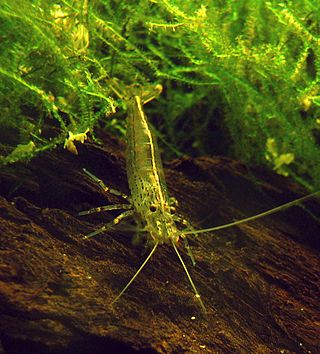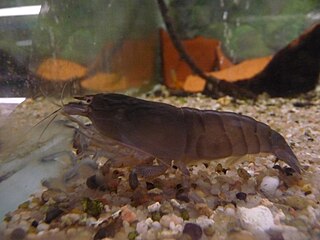
The Caridea, commonly known as caridean shrimp or true shrimp, from the Greek word καρίς, καρίδος, are an infraorder of shrimp within the order Decapoda. This infraorder contains all species of true shrimp. They are found widely around the world in both fresh and salt water. Many other animals with similar names – such as the mud shrimp of Axiidea and the boxer shrimp of Stenopodidea – are not true shrimp, but many have evolved features similar to true shrimp.

The Decapoda or decapods are an order of crustaceans within the class Malacostraca, and includes crabs, lobsters, crayfish, shrimp, and prawns. Most decapods are scavengers. The order is estimated to contain nearly 15,000 extant species in around 2,700 genera, with around 3,300 fossil species. Nearly half of these species are crabs, with the shrimp and Anomura including hermit crabs, porcelain crabs, squat lobsters making up the bulk of the remainder. The earliest fossils of the group date to the Devonian.

The Cephalocarida are a class in the subphylum Crustacea comprising only 12 species. Both the nauplii and the adults are benthic. They were discovered in 1955 by Howard L. Sanders, and are commonly referred to as horseshoe shrimp. They have been grouped together with the Remipedia in the Xenocarida. Although a second family, Lightiellidae, is sometimes used, all cephalocaridans are generally considered to belong in just one family: Hutchinsoniellidae. Fossil records of cephalocaridans have been found in the Ordovician Castle Bank site.

Aeger is a genus of fossil prawns. They first occur in the Early Triassic, and died out at the end of the Late Cretaceous. A total of 21 species are known.

Atyidae is a family of shrimp, present in all tropical and most temperate waters of the world. Adults of this family are almost always confined to fresh water. This is the only family in the superfamily Atyoidea.
Physetocaris is a monotypic genus of caridean shrimp, containing a single species, Physetocaris microphthalma.

Typhlatya is a genus of shrimp in the family Atyidae. These are small, stygobitic shrimp found in the West Mediterranean region, Caribbean region, Ascension Island and the Galápagos, although the individual species often have very small ranges. Species in this genus are found in salt, brackish and fresh waters, mostly in anchialine habitats and none in the open sea.

Rhynchocinetes is a genus of shrimp, containing the following 14 species:
Atya is a genus of freshwater shrimp of the family Atyidae, ranging through the Antilles and along the Atlantic and Pacific slopes of Central and South America and in western Africa. It contains the following species:

Psalidopus is a genus of shrimp placed in its own family, Psalidopodidae, and superfamily, Psalidopodoidea. It comprises three species, one in the western Atlantic Ocean, and two in the Indo-Pacific.

Procaris ascensionis is a species of shrimp, known only from two anchialine pools on Ascension Island; the larger of the two pools is about 4.5 metres (15 ft) in diameter and contains 45 centimetres (18 in) of water.

The Processidae are a family of shrimp, comprising 65 species in five genera, and the only family in the superfamily Processoidea. They are small, nocturnal animals, mostly living in shallow seas, particularly on grass flats. The first pereiopods are usually asymmetrical, with a claw on one, but not the other. The rostrum is generally a simple projection from the front of the carapace, with two teeth, one at the tip, and one further back.
Fenner Albert Chace Jr. was an American carcinologist.

Heterocarpus is a genus of deep-sea shrimp, mainly of tropical areas all over the world.

Campylonotoidea is a superfamily of shrimp, containing the two families Campylonotidae and Bathypalaemonellidae. Fenner A. Chace considered it to be the sister group to the much larger superfamily Palaemonoidea, with which it shares the absence of endopods on the pereiopods, and the fact that the first pereiopod is thinner than the second. Using molecular phylogenetics, Bracken et al. proposed that Campylonotoidea may be closer to Atyoidea. There are sixteen described species in 3 genera; no fossils are known.

Atya gabonensis is a species of freshwater shrimp from West Africa. Note that accounts of its occurrence in South America are erroneous, and likely another species. It is an omnivorous filter feeder that uses feather-like claspers to filter particles from the water. It can grow to 15 centimetres. It has many common names, including African fan shrimp, African filter shrimp, African giant shrimp, vampire shrimp, blue rhino shrimp, Gabon shrimp, and Cameroon fan shrimp.

A shrimp is a crustacean with an elongated body and a primarily swimming mode of locomotion – typically belonging to the Caridea or Dendrobranchiata of the order Decapoda, although some crustaceans outside of this order are also referred to as "shrimp".

Crustaceans are invertebrate animals that constitute one group of arthropods that are a part of the subphylum Crustacea, a large, diverse group of mainly aquatic arthropods including decapods, seed shrimp, branchiopods, fish lice, krill, remipedes, isopods, barnacles, copepods, opossum shrimps, amphipods and mantis shrimp. The crustacean group can be treated as a subphylum under the clade Mandibulata. It is now well accepted that the hexapods emerged deep in the Crustacean group, with the completed pan-group referred to as Pancrustacea. The three classes Cephalocarida, Branchiopoda and Remipedia are more closely related to the hexapods than they are to any of the other crustaceans.
Neopontonides beaufortensis is a crustacean species in the family Palaemonidae first described by Lancelot Alexander Borradaile in 1920.
















